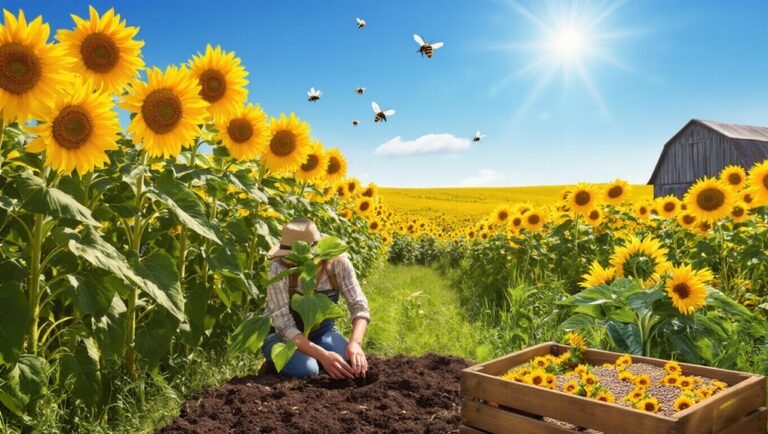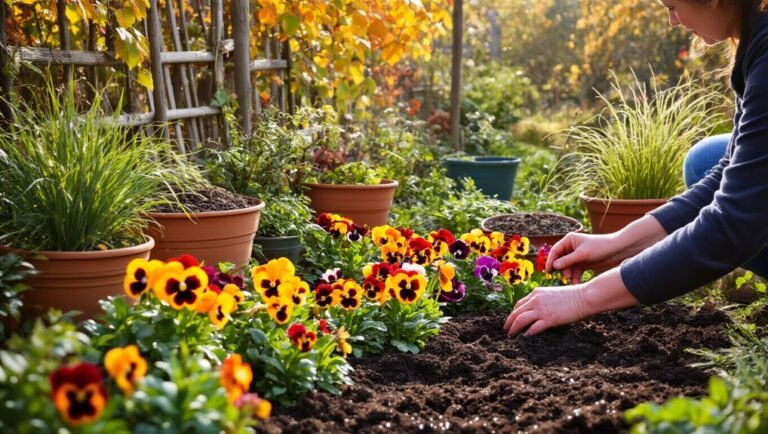Fall gardening offers a chance to grow vibrant vegetables and stunning flowers while prepping your garden for winter. Start by choosing cool-weather crops like kale and carrots, and plant them about 6-8 weeks before the first frost. Enhance your garden’s beauty with colorful pansies and hearty mums. Don’t forget soil preparation—loosen it, enrich it with compost, and apply mulch. Protect your garden from frost and learn the best harvesting tips to enjoy your seasonal bounty. Discover more ways to elevate your fall garden!
Key Takeaways
- Select cool-weather vegetables like kale, Brussels sprouts, and root vegetables for optimal fall planting, considering local climate and frost dates.
- Incorporate vibrant flowers such as pansies, violas, and mums to enhance autumn aesthetics and attract pollinators.
- Prepare soil by clearing debris, loosening it, and adding organic matter to enrich nutrient levels for fall gardening.
- Water deeply but infrequently in fall, using balanced fertilizers to support root development before winter sets in.
- Harvest vegetables in the morning for freshness, and maintain tools for readiness, ensuring a successful gardening experience.
Choosing the Right Fall Vegetables
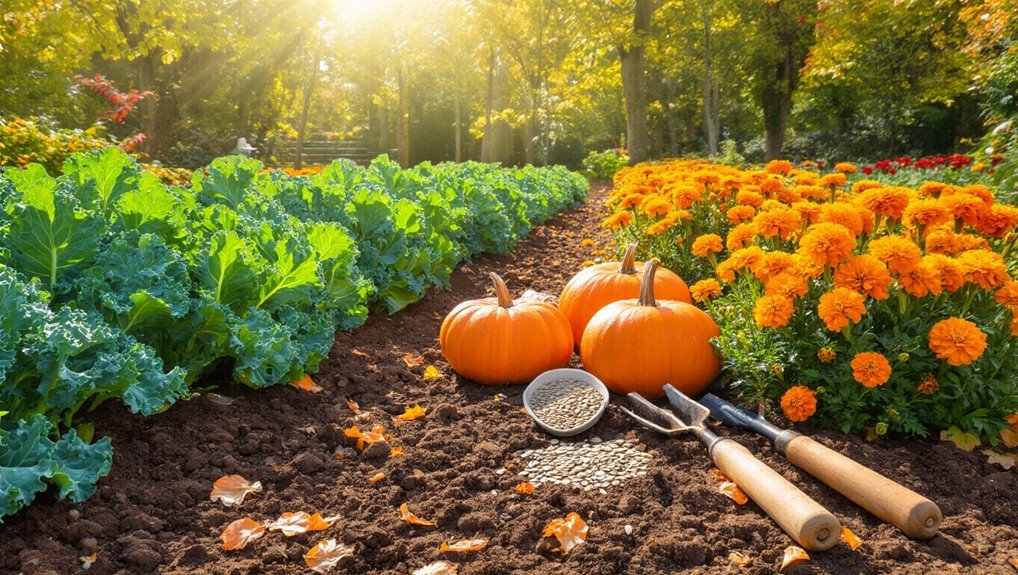
When should you start thinking about your fall vegetable garden? Ideally, you should begin planning in late summer.
Consider the vegetables that thrive in cooler temperatures, such as kale, Brussels sprouts, and carrots. These crops love the crisp air and can even taste sweeter after a frost. When preparing your planting beds, consider using Organic Mulching Materials like straw to help retain moisture and suppress weeds as your vegetables grow.
Don’t forget about root vegetables like beets and turnips, which are perfect for fall planting.
You’ll also want to think about your local climate and frost dates. Some veggies can handle light frosts, while others need protection or should be planted later.
It’s essential to choose varieties suited for your growing zone. By selecting the right fall vegetables, you’ll enjoy a bountiful harvest as the seasons change.
To give your fall garden an extra boost, consider using compost bins to enrich your soil before planting.
Happy gardening!
Planting Timing and Techniques
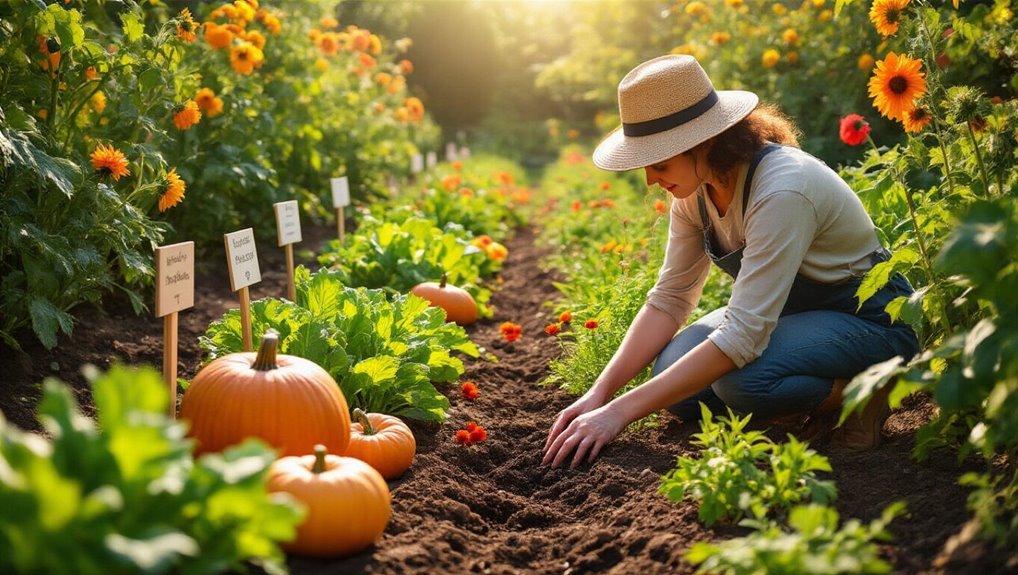
As you prepare to plant your fall garden, it’s crucial to consider the timing and techniques that will set you up for success. Start by checking your local frost dates; knowing when to plant will help you choose the right crops. Aim to sow seeds or transplant seedlings about six to eight weeks before the first expected frost.
When planting, consider using row covers to protect young plants from chilly nights. Space your seeds or seedlings appropriately to allow for air circulation and healthy growth. For gardeners who want to maximize root development and drainage, grow bags are an excellent option for both vegetables and flowers.
Water consistently but avoid over-saturation, as fall weather can be unpredictable. Finally, keep an eye on pests and diseases, as they can still thrive in cooler temperatures.
For gardeners looking to get a head start, seed starting kits can simplify the process of starting seeds indoors before transplanting them into your fall garden. With these strategies, you’ll enjoy a thriving fall garden.
Essential Fall Flower Varieties
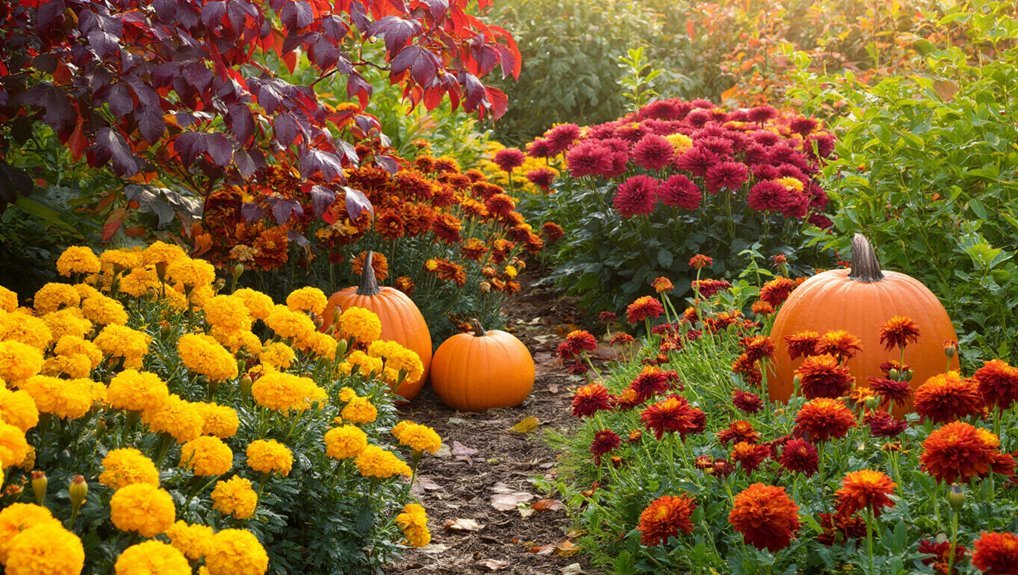
After you’ve established your fall garden with the right planting techniques, it’s time to think about adding vibrant flowers that complement your vegetable crops.
Consider planting pansies and violas; they thrive in cooler temperatures and bring a burst of color. Mums are another excellent choice, providing stunning blooms that last well into autumn. For a stylish display, arrange your flowers in beautiful plant pots to elevate your garden’s aesthetic and protect sensitive roots from early frosts.
If you’re looking for something unique, try planting ornamental kale or cabbage, which adds texture and interest. Don’t forget about asters, which attract pollinators and create a lovely late-season display.
Lastly, snapdragons can add height and charm, blooming until frost. By incorporating these essential fall flower varieties, you’ll enhance your garden’s beauty while supporting your vegetable growth.
For gardeners interested in edible options, you can explore Edible Flower Seeds that not only add color and beauty but are also safe to consume fresh from your garden.
Happy gardening!
Preparing Your Soil for Autumn
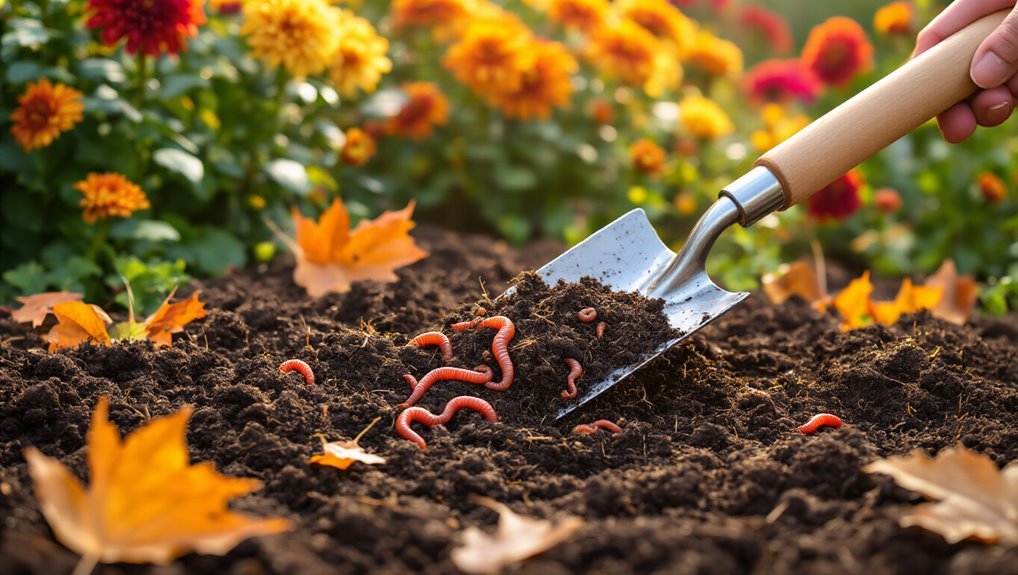
To ensure your garden thrives through the colder months, preparing your soil for autumn is essential.
Start by clearing out any debris, dead plants, and weeds to prevent pests and diseases from overwintering. Next, loosen the soil with a garden fork or tiller to improve aeration. Incorporating Compost Tumblers into your routine can make it easier to create nutrient-rich compost for your soil.
Adding organic matter, like compost or well-rotted manure, enriches your soil while enhancing its structure. If you haven’t already, test your soil’s pH and nutrient levels to identify any deficiencies.
Consider incorporating cover crops like clover or rye, which not only protect your soil but also improve fertility when tilled under in spring.
Applying a layer of mulch helps retain soil moisture, regulate temperature, and suppress weeds during the fall and winter months.
Taking these steps will set your garden up for a healthy, vibrant growth season come spring.
Watering and Fertilizing in Fall
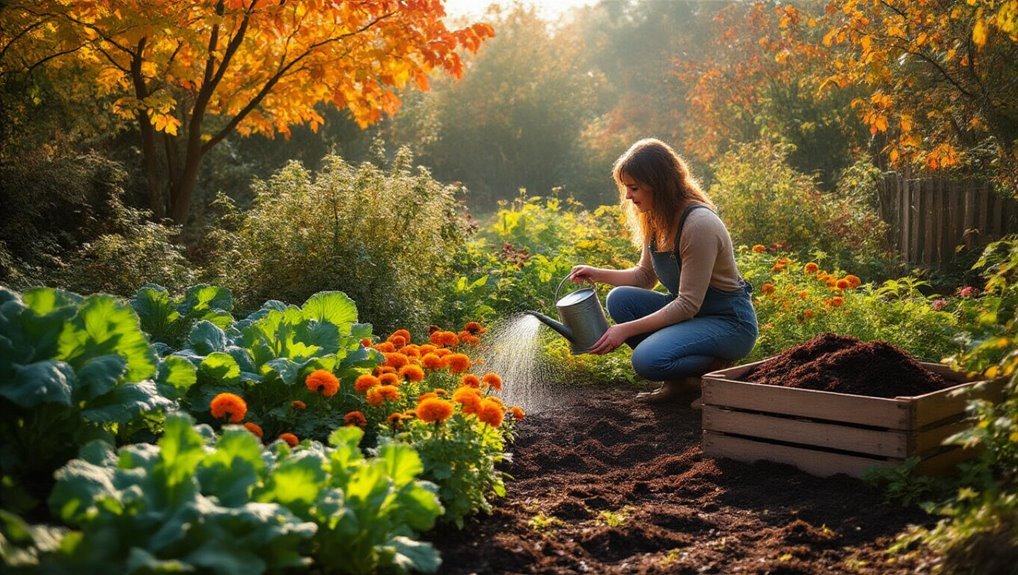
Once your soil is prepped and ready, focusing on watering and fertilizing during fall is key to supporting your garden’s health.
As temperatures drop, you’ll want to adjust your watering habits and provide essential nutrients to your plants. Some of the best plant food options are specifically formulated to nourish your garden through seasonal changes. Here are some tips to keep in mind:
- Water deeply but less frequently: Aim for about an inch of water per week to encourage deep root growth.
- Use a balanced fertilizer: Choose one with a higher potassium content to promote root development.
- Apply fertilizers in the early fall: This timing gives your plants a chance to absorb nutrients before winter.
- Monitor rainfall: Adjust your watering schedule based on natural precipitation to prevent overwatering.
For a convenient and effective way to nourish your garden, consider using Plant Fertilizer Tablets, which provide essential nutrients directly to the root zone.
Protecting Your Garden From Frost
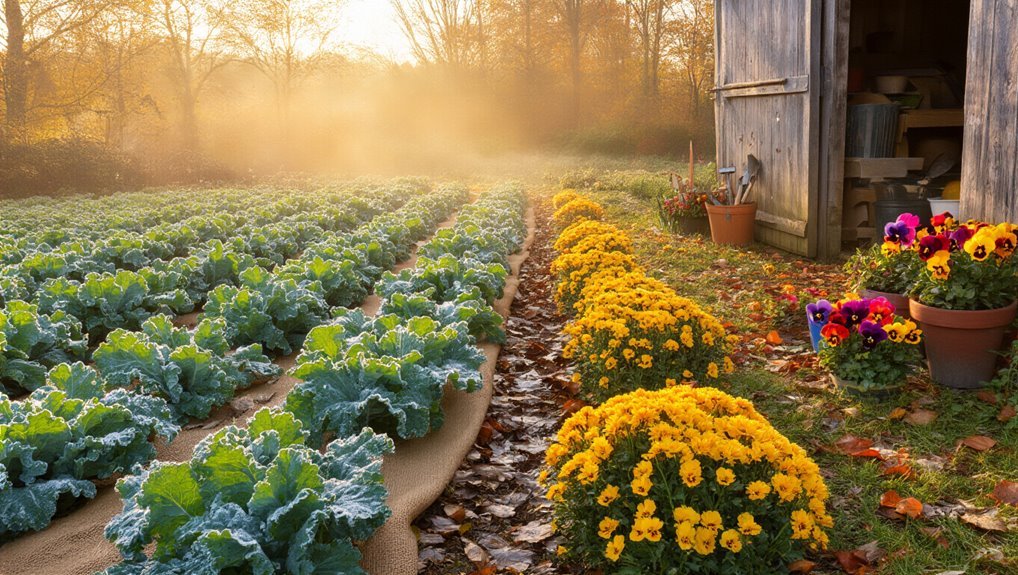
As temperatures dip and the threat of frost looms, protecting your garden becomes crucial for preserving your hard work.
Start by covering vulnerable plants with frost cloths or old blankets, ensuring the coverings reach the ground to trap heat. If it’s a particularly cold night, consider using row covers or cloches for added protection. For additional defense against pests, consider installing garden netting to shield your plants while still allowing air and light to pass through.
You can also group potted plants together and move them indoors or to a sheltered area. A layer of mulch can insulate soil and roots, preventing freeze damage.
Additionally, watering your garden before a frost can help, as moist soil retains heat better than dry soil.
For gardeners looking for specialized solutions, Frost Protection Covers are available and can provide an effective barrier against cold weather to safeguard your plants.
Harvesting Tips for Fall Crops
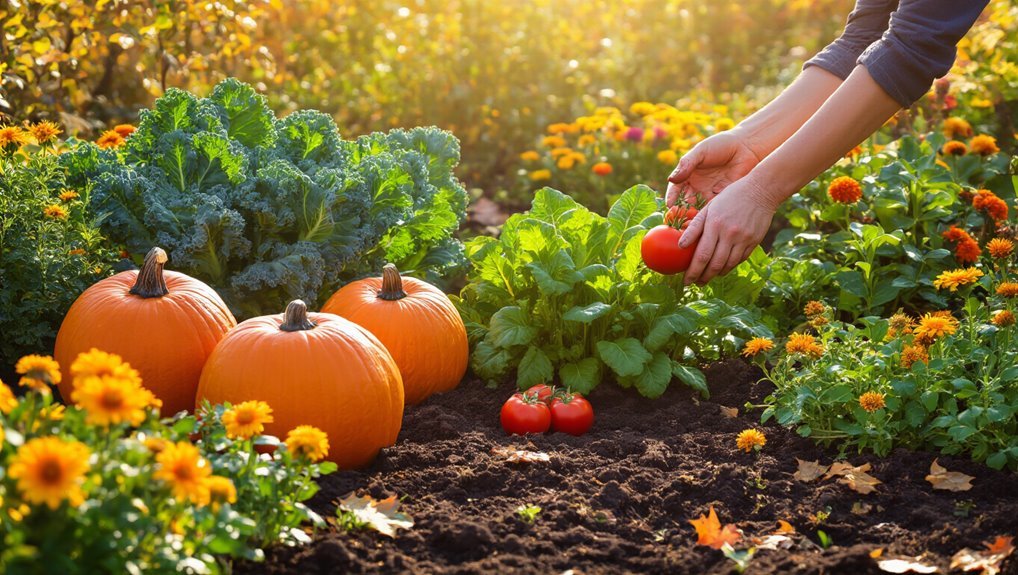
When the days grow shorter and cooler, it’s time to reap the rewards of your fall garden. Harvesting your crops at the right time ensures the best flavor and quality.
Here are some tips to help you:
- Check for Ripeness: Look for color, size, and firmness; each vegetable has its own optimal harvest indicators.
- Harvest in the Morning: Cool temperatures help preserve freshness and flavor, so pick your crops early in the day.
- Use Sharp Tools: A clean, sharp knife or scissors minimizes damage to the plant and makes harvest easier. For best results, try using pruning shears designed for gardening, as they provide precise cuts and reduce strain on your hands.
- Handle with Care: Gently place harvested produce in baskets to avoid bruising and spoilage.
For a more efficient harvest, consider using garden harvesting tools such as sickles, which are designed specifically for gathering a variety of crops with ease.
Enjoy the fruits of your labor and savor the flavors of fall!
Preparing Your Garden for Winter
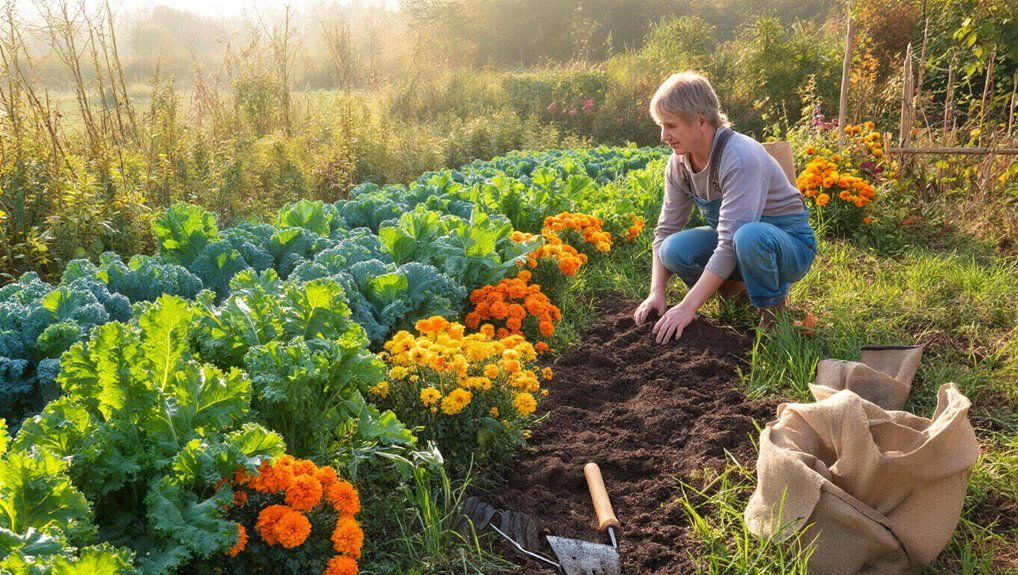
Preparing your garden for winter is essential to ensure it thrives come spring. Start by cleaning up any debris, like dead plants and fallen leaves, to prevent pests and diseases.
Next, consider mulching your garden beds. A thick layer of mulch protects plant roots from freezing temperatures and helps retain soil moisture. Adding outdoor composting systems to your garden routine can create nutrient-rich compost to further improve soil health before winter.
If you’ve got perennials, cut them back according to their specific needs, but leave some for winter interest. You might also want to plant cover crops to enrich the soil.
Finally, don’t forget to check your tools and storage; clean and repair them now so they’re ready for use when spring arrives.
To maximize your fall prep, consider using raised garden beds, which can improve drainage and make it easier to manage soil conditions throughout the colder months.
With these steps, you’re setting up your garden for a successful season ahead.
Frequently Asked Questions
Can I Grow Vegetables Indoors During the Fall Season?
Yes, you can grow vegetables indoors during the fall season! Just ensure you have adequate light, temperature control, and proper containers. With a bit of care, you’ll enjoy fresh produce right from your home.
What Tools Are Essential for Fall Gardening?
You’ll need essential tools for fall gardening, like a sturdy spade, pruning shears, gloves, and a rake. These help you prepare the soil, maintain plants, and collect leaves efficiently, ensuring a successful garden transition.
How Do I Attract Beneficial Insects in the Fall?
To attract beneficial insects in the fall, plant diverse flowers, avoid pesticides, and provide shelter with native plants. You’ll create a welcoming environment, encouraging pollinators and natural pest controllers to thrive in your garden.
What Are Common Fall Gardening Pests to Watch For?
Did you know that over 30% of garden pests thrive in cooler temperatures? As fall approaches, keep an eye out for aphids, spider mites, and whiteflies, as they can quickly damage your plants if left unchecked.
How Can I Extend My Fall Growing Season?
To extend your fall growing season, consider using row covers, cold frames, or greenhouses. Plant hardy crops like kale and spinach, and ensure your soil is well-prepared to retain warmth and moisture for optimal growth.
Conclusion
As the leaves turn and the air cools, your garden can still thrive with a little fall TLC. By choosing the right vegetables and flowers, prepping your soil, and protecting your plants from frost, you’ll create a vibrant autumn oasis. Remember, gardening in fall is like painting a masterpiece—each season adds a new layer of color and life. Embrace this beautiful time of year, and you’ll reap the rewards come harvest time while setting the stage for winter rest.
